Livestock Guardian Dogs For Your Flock: A Pictorial Primer
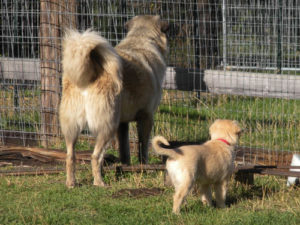
Isaac demonstrates for puppy Khloe how to guard
In the last 14 years, we have acquired nine LGDs: two mixed Maremma/Anatolian/Great Pyrenees and then a wonderful succession of seven Anatolians from Chyril Walker at Shepherds Rest. Along the way, we made countless mistakes but also learned what works and what doesn’t work for our flock and our “style.” Although we are firm believers in the uniqueness of each shepherd’s way of raising and handling her LGDs, we hope others considering LGDs will find something useful from our experience. And besides, I just love talking about my dogs.
How I wish I had a good picture of every task, every challenge, every reward and every question associated with LGDs, but of course I don’t. If I can refrain from running at the mouth too much, the pictures I do have should give you a pretty good notion of how LGDs operate … at least on our farm. Please note that I have interspersed pictures of all our dogs, but if you have a favorite, you can follow his or her pictures throughout the post. Or send me a note for more pictures of your fave!
In a nutshell, we got all our Anatolians as 7-10 week old puppies; they live 24/7 with our sheep and llama; we have them sufficiently leash trained to be able to take them to the vet in the event of injuries; and they will sit quietly for food. They do not “show,” they do not do tricks, and they do not get treats. In 14 years we have not lost a single sheep to predators when we had an effective dog on patrol. All of our dogs are affectionate with us.
BRINGING AN LGD PUPPY HOME TO YOUR FARM
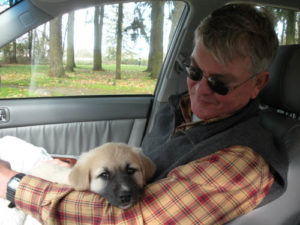
The cushiest job Khloe will ever have!
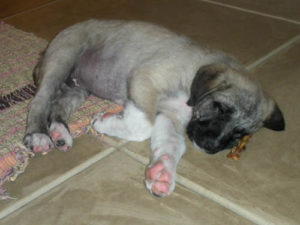
Is it any wonder we called him Cool Paw Luke?
The next morning, the pup goes out to assume its duties with the sheep and we summon our vet to check out the puppy’s health, something Chyril insists on.
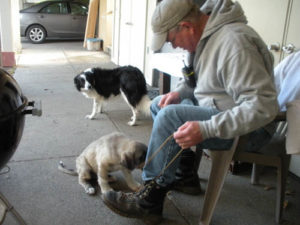
Khloe inspects Steve’s boots while Mollie Collie indicates her displeasure at having to put up with this little pipsqueak
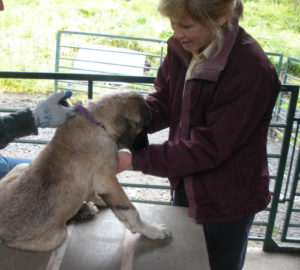
Doctor Susan checks out Luke as a puppy, declares him fit, and amply endowed in the paw department
We place our puppies in a pasture with the adult dog we think will be the best trainer based on the temperament testing Chyril does with her pups. [Author’s note: we were deeply skeptical about these assessments at first, but by and large they have been spot on]. The main job the first day is to be sure the puppy is introduced to each of the other dogs, the sheep, the llama, and adult feet.
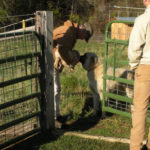
Khloe meets her first big dog, Jacob
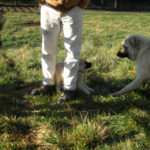
Jake’s not sure about this new creature
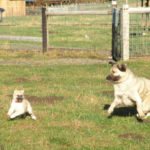
Oh boy, let’s romp!
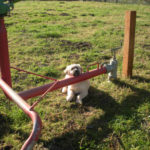
This LGD business is tiring!
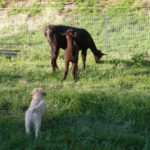
Oh my, that baby llama’s a lot bigger than I am
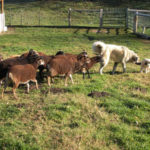
Who is more curious about the puppy, big dog Isaac or the sheep?
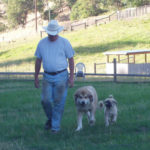
Puppy Jacob tags along with TJ and the boss
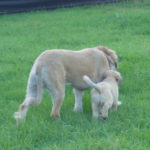
Can you sense the bond forming even on day one?
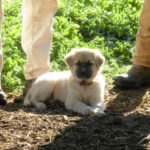
This LGD business is a snap. Just give me a couple of pairs of tall legs to snuggle up to and I’m good.
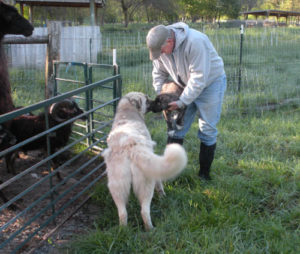
2009 Jacob welcomed Khloe. 2012 Khloe welcomed Alfie.
OLDER DOGS MODEL FOR YOUNGER DOGS
People often ask us how we train our dogs to protect our sheep. Simple answer: we don’t. Most of it is instinct, with a healthy dose of imitation. Each puppy learns how to behave from watching his or her paired older dog.
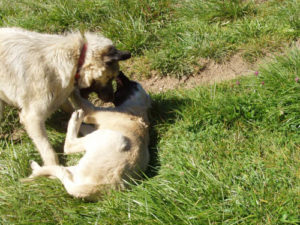
Isaac letting Jacob know who’s boss
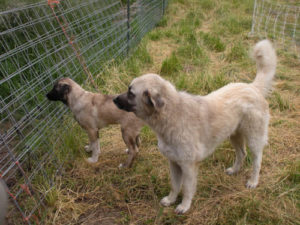
Luke imitating Jacob’s watchful eye. A biker on the road or a coyote in the upper pasture?
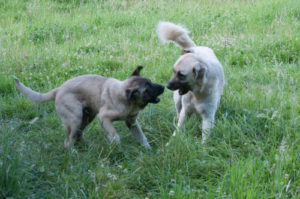
Puppy Luke testing Jacob
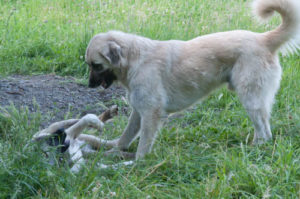
Jacob reminding Luke who’s the top dog
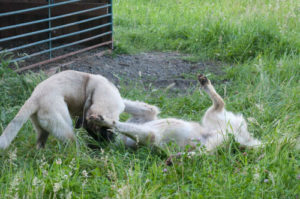
Constructive roughhousing lets off a lot of steam, but eventually Jacob will call it off
In fairness, our older dogs are not above goading one of the younger ones into friendly retaliation.
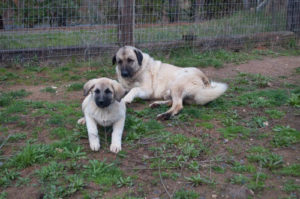
Notice how stately older Luke provokes Ben just when Ben is finally lying down peaceably?
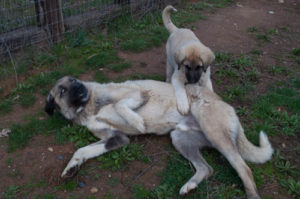
Game on!
WHERE HUMAN TRAINING COMES IN
No matter how aloof and independent a good LGD is, and they do need a high degree of self-confidence in order to make their own judgments about how to respond to real or perceived threats to their flocks, we still need to train our dogs in the basics of good behavior with us and to some extent with the other dogs. The good news is that LGDs, or at least Anatolians, can be trained in basic commands (sit, stay, follow on leash without lunging). The side benefit to training is it also creates a vital bond between us and our dogs. For example, we routinely put our hands in our dogs’ huge mouths so that if they get injured in the mouth area, they will trust us enough to let us feel around in there. I don’t have a picture of this, maybe in the next update.
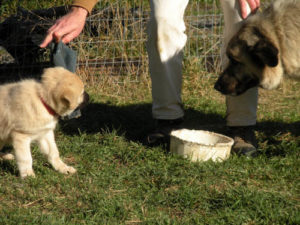
“Khloe, that is not your food dish!”
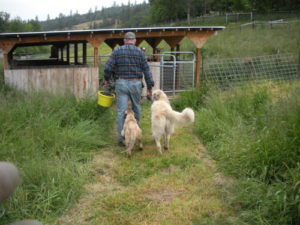
Young Jacob pushing the boundaries on appropriate tagalong behavior. See next photo.
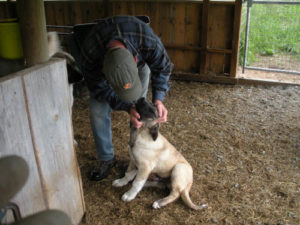
Just a couple of minutes later, Jacob had pushed too far, time for a nose-to-nose talking to from the human “Alpha Dog”
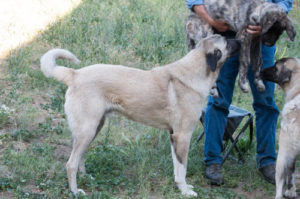
Dangling a puppy over your arm is a tried and true way to get him to trust you.
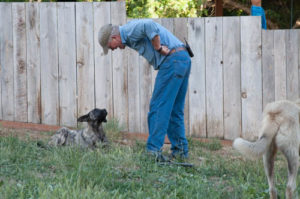
But sometimes, he’s just a bad boy, never mind trust.
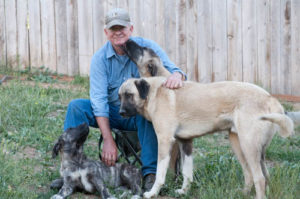
Correction over and taken, it’s okay to let the puppy know you still love him
Sometimes, despite your best efforts, those trusty LGDs will have their own way.
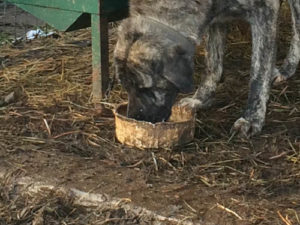
Several of our dogs are incorrigible bowl chewers. We eventually gave up and converted to stainless steel bowls
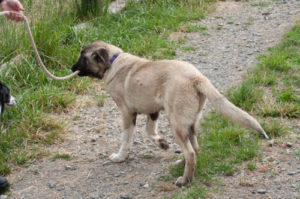
Still working on that pesky leash training
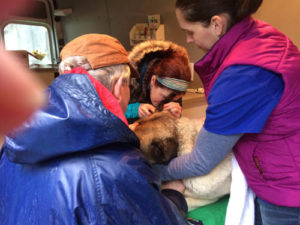
All those hours of interacting and gaining trust really pays off when it comes time for the vet to stick a cold hard instrument into the dog’s ear
THE PAYOFF: ADULT LGDs “SETTLE DOWN” TO WORK
As we’ve said often on the website and on social media, it takes between 6 months and up to a year and a half for an LGD, or at least our Anatolians, to settle in, not chase the sheep in play, and become reliable enough for them to live 24/7 with the sheep. When that happens with each puppy, it’s glorious to behold.
Khloe was fairly quick to settle down, to the point that we can have her with the little lambs or in a large field of adults.
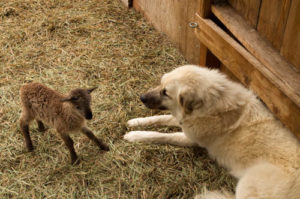
Having a wee lamb rush up to her doesn’t faze Khloe
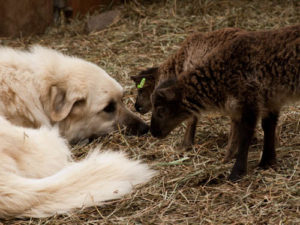
… no matter how close the lamb
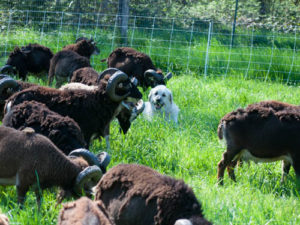
Adult sheep are okay to guard, too
Luke took longer to “settle,” but when he did, boy, was he settled! Ditto Alfie.
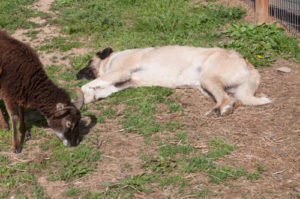
On guard at night, our dogs sleep peacefully among the sheep during the day
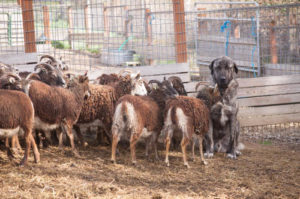
160 pounds of Alfie calm
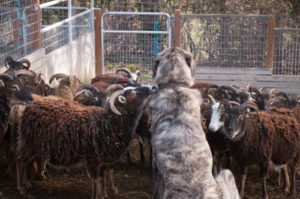
You want to nuzzle? I’m good for it.
YES, LGDs REALLY DO PROTECT SHEEP
Not much commentary needed here. Sometimes the dogs are alert but not worked up, sometimes they just see something, and occasionally they are on full guard pose.
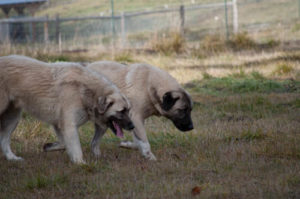
A casual patrol
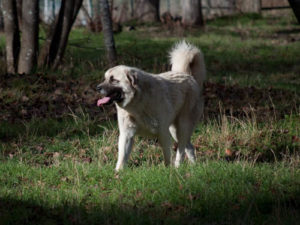
or a more focused investigation
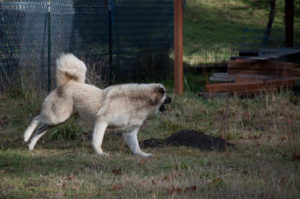
Can turn instantly into red alert
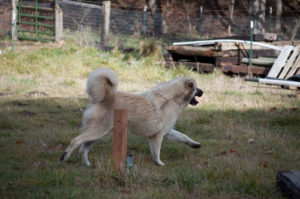
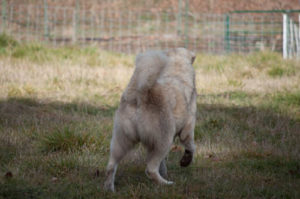
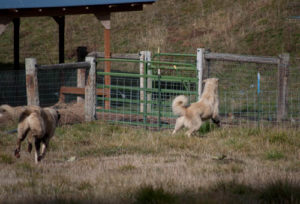
LGDs APPRECIATE COMPANIONSHIP, TOO
A high percentage of hobby farms and ranches have one LGD at most. Our dogs can see each other in their separate pastures, of course, and they love playdays or just loafing with each other for a few hours.
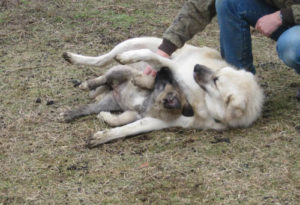
Normally aloof Khloe can’t resist snuggle time with puppy Maggie
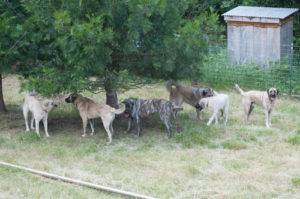
Only once have we had all our dogs together for a playday, and they loved it!
THE JOYS, AND OCCASIONAL SORROWS, OF HAVING LGDs
Until you’ve had upwards of 160 pounds of furry affection leaning against your leg for no reason other than to share canine/human love, or watched a dog that can kill a wolf roll over for a belly rub, you can’t fully appreciate why anyone in their right mind would keep even one of these huge dogs, much less several of them. It’s not that easy pushing 400 pounds of dog food through a crowded Costco, hoping a child won’t dart in front of the cart and test the laws of inertia. But the satisfactions and joys have been worth it for me and even more for Steve for well over a decade, and we wouldn’t have missed this part of our Grand Sheep Adventure for anything.
I decided to write this post because we are facing the loss of our aptly-named Cool Paw Luke within a short time, and as I scrolled through my pictures of him, I unearthed a lot of fond memories of all our dogs. I hope you have enjoyed a brief glimpse into a few of the aspects of successfully, and happily, owning Livestock Guardian Dogs.
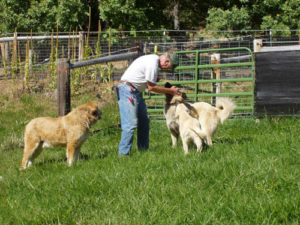
2007 with TJ, Isaac, and puppy Jacob
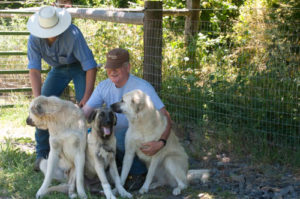
2011 with Jacob, Khloe and young Luke
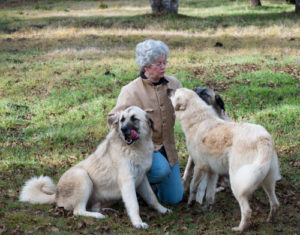
2012 with Jacob, Khloe and Luke

2015: Luke is more interested in a good head rub than in my new red boots

For now …